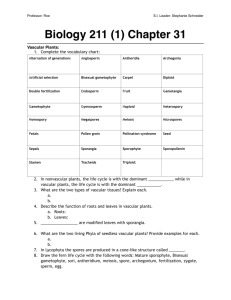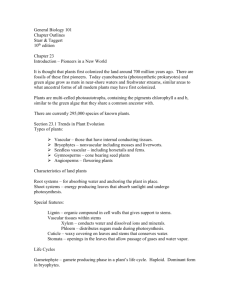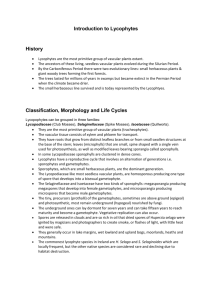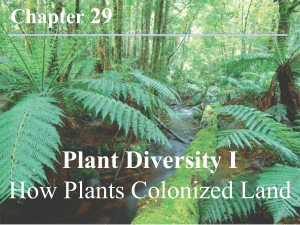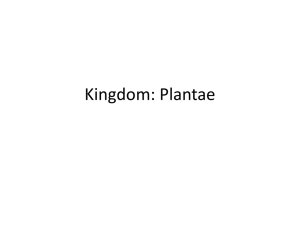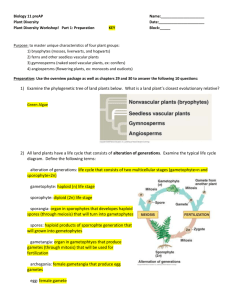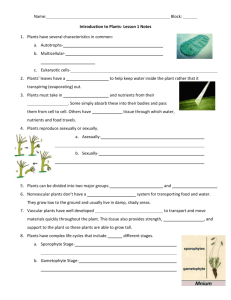Plant evolution
advertisement
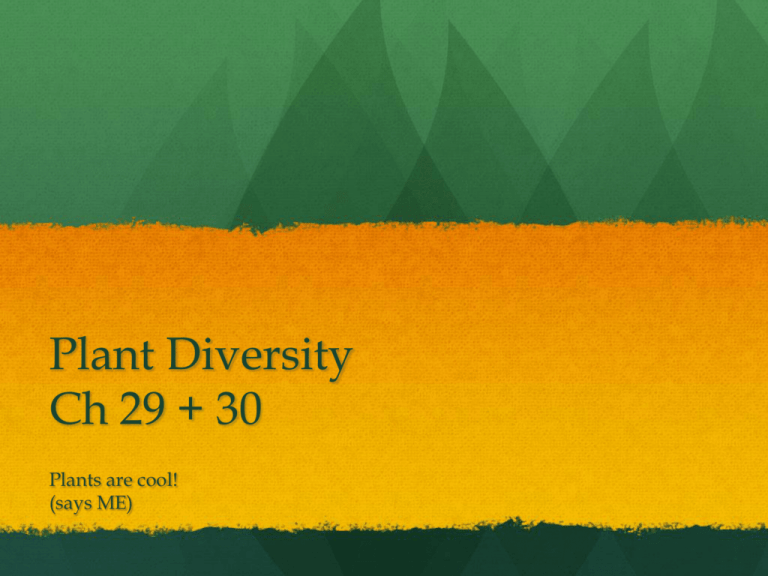
Plant Diversity Ch 29 + 30 Plants are cool! (says ME) Overview: The Greening of Earth • Looking at a lush landscape, it is difficult to imagine the land without any plants or other organisms • For more than the first 3 billion years of Earth’s history, the terrestrial surface was lifeless • Since colonizing land, plants have diversified into roughly 290,000 living species • Plants supply oxygen and are the ultimate source of most food eaten by land animals Concept 29.1: Land plants evolved from green algae • Green algae called charophytes are the closest relatives of land plants •Many characteristics of land plants also appear in a variety of algal clades, mainly algae •However, land plants share four key traits only with charophytes: –Rose-shaped complexes for cellulose synthesis –Peroxisome enzymes –Structure of flagellated sperm –Formation of a phragmoplast Adaptations Enabling the Move to Land • In charophytes a layer of a durable polymer called sporopollenin prevents exposed zygotes from drying out • The movement onto land by charophyte ancestors provided unfiltered sun, more plentiful CO2, nutrient-rich soil, and few herbivores or pathogens • Land presented challenges: a scarcity of water and lack of structural support • The accumulation of traits that facilitated survival on land may have opened the way to its colonization by plants • Systematists are currently debating the boundaries of the plant kingdom • Some biologists think the plant kingdom should be expanded to include some or all green algae • Until this debate is resolved, we will retain the embryophyte definition of kingdom Plantae Fig. 29-4 Red algae Chlorophytes Plantae Embryophytes Streptophyta Charophytes Viridiplantae ANCESTRAL ALGA Derived Traits of Plants • Four key traits appear in nearly all land plants but are absent in the charophytes: – Alternation of generations (with multicellular, dependent embryos) – Walled spores produced in sporangia – Multicellular gametangia – Apical meristems •Additional derived traits such as a cuticle and secondary compounds evolved in many plant species •Symbiotic associations between fungi and the first land plants may have helped plants without true roots to obtain nutrients Alternation of Generations and Multicellular, Dependent Embryos • Plants alternate between two multicellular stages, a reproductive cycle called alternation of generations • The gametophyte is haploid and produces haploid gametes by mitosis • Fusion of the gametes gives rise to the diploid sporophyte, which produces haploid spores by meiosis • Land plants are called embryophytes because of the dependency of the embryo on the parent Fig. 29-5a Gametophyte (n) Mitosis n n Spore Gamete from another plant Mitosis n n Gamete MEIOSIS FERTILIZATION 2n Mitosis Sporophyte (2n) Alternation of generations Zygote Walled Spores Produced in Sporangia • The sporophyte produces spores in organs called sporangia • Diploid cells called sporocytes undergo meiosis to generate haploid spores • Spore walls contain sporopollenin, which makes them resistant to harsh environments Fig. 29-5c Spores Sporangium Longitudinal section of Sphagnum sporangium (LM) Sporophyte Gametophyte Sporophytes and sporangia of Sphagnum (a moss) Multicellular Gametangia • Gametes are produced within organs called gametangia • Female gametangia, called archegonia, produce eggs and are the site of fertilization • Male gametangia, called antheridia, are the site of sperm production and release Fig. 29-5d Female gametophyte Archegonium with egg Antheridium with sperm Male gametophyte Archegonia and antheridia of Marchantia (a liverwort) Apical Meristems • Plants sustain continual growth in their apical meristems • Cells from the apical meristems differentiate into various tissues Fig. 29-5e Apical meristem of shoot Shoot Developing leaves 100 µm Apical meristems Apical meristem of root Root 100 µm Vascular VS Nonvascular • Land plants can be informally grouped based on the presence or absence of vascular tissue • Most plants have vascular tissue; these constitute the vascular plants • Nonvascular plants are commonly called bryophytes • Seedless vascular plants can be divided into clades – Lycophytes (club mosses and their relatives) – Pterophytes (ferns and their relatives) • A seed is an embryo and nutrients surrounded by a protective coat • Seed plants form a clade and can be divided into further clades: – Gymnosperms, the “naked seed” plants, including the conifers – Angiosperms, the flowering plants Table 29-1 Fig. 29-7 1 Origin of land plants (about 475 mya) 2 Origin of vascular plants (about 420 mya) 3 Origin of extant seed plants (about 305 mya) Mosses Pterophytes (ferns, horsetails, whisk ferns) 3 Angiosperms 450 400 350 300 Millions of years ago (mya) 50 0 Seed plants Gymnosperms Vascular plants 2 Seedless vascular plants Lycophytes (club mosses, spike mosses, quillworts) 500 Land plants Hornworts 1 Nonvascular plants (bryophytes) ANCESTRAL GREEN ALGA Liverworts Concept 29.2: Mosses and other nonvascular plants have life cycles dominated by gametophytes • Bryophytes are represented today by three phyla of small herbaceous (nonwoody) plants: – Liverworts, phylum Hepatophyta – Hornworts, phylum Anthocerophyta – Mosses, phylum Bryophyta • Mosses are most closely related to vascular plants Fig. 29-UN1 Nonvascular plants (bryophytes) Seedless vascular plants Gymnosperms Angiosperms Bryophytes are Gametophyte Dominant • In all three bryophyte phyla, gametophytes are larger and longer-living than sporophytes • Sporophytes are typically present only part of the time Fig. 29-8-3 Raindrop Sperm “Bud” Male gametophyte (n) Key Haploid (n) Diploid (2n) Protonemata (n) Antheridia “Bud” Egg Spores Gametophore Female Archegonia gametophyte (n) Spore dispersal Rhizoid Peristome FERTILIZATION Sporangium MEIOSIS Mature sporophytes Seta Capsule (sporangium) Foot Zygote (2n) (within archegonium) Embryo 2 mm Archegonium Capsule with peristome (SEM) Young sporophyte (2n) Female gametophytes Fig. 29-9d Polytrichum commune, hairy-cap moss Capsule Seta Sporophyte (a sturdy plant that takes months to grow) Gametophyte The Ecological and Economic Importance of Mosses • Moses are capable of inhabiting diverse and sometimes extreme environments, but are especially common in moist forests and wetlands • Some mosses might help retain nitrogen in the soil Fig. 29-10 RESULTS Annual nitrogen loss (kg/ha) 6 5 4 3 2 1 0 With moss Without moss • Sphagnum, or “peat moss,” forms extensive deposits of partially decayed organic material known as peat • Sphagnum is an important global reservoir of organic carbon Fig. 29-11 (a) Peat being harvested (b) “Tollund Man,” a bog mummy Concept 29.3: Ferns and other seedless vascular plants were the firstandplants to grow tallthe • Bryophytes bryophyte-like plants were prevalent vegetation during the first 100 million years of plant evolution • Vascular plants began to diversify during the Devonian and Carboniferous periods • Vascular tissue allowed these plants to grow tall • Seedless vascular plants have flagellated sperm and are usually restricted to moist environments Fig. 29-UN2 Nonvascular plants (bryophytes) Seedless vascular plants Gymnosperms Angiosperms Origins and Traits of Vascular Plants • Fossils of the forerunners of vascular plants date back about 420 million years • These early tiny plants had independent, branching sporophytes • Living vascular plants are characterized by: • Life cycles with dominant sporophytes • Vascular tissues called xylem and phloem • Well-developed roots and leaves Life Cycles with Dominant Sporophytes • In contrast with bryophytes, sporophytes of seedless vascular plants are the larger generation, as in the familiar leafy fern • The gametophytes are tiny plants that grow on or below the soil surface Fig. 29-13-3 Key Haploid (n) Diploid (2n) MEIOSIS Spore dispersal Spore (n) Sporangium Sporangium Mature sporophyte (2n) Antheridium Young gametophyte Mature gametophyte (n) Archegonium Egg New sporophyte Zygote (2n) Sorus Gametophyte Fiddlehead FERTILIZATION Sperm Transport in Xylem and Phloem • Vascular plants have two types of vascular tissue: xylem and phloem • Xylem conducts most of the water and minerals and includes dead cells called tracheids • Phloem consists of living cells and distributes sugars, amino acids, and other organic products • Water-conducting cells are strengthened by lignin and provide structural support • Increased height was an evolutionary advantage Evolution of Roots • Roots are organs that anchor vascular plants • They enable vascular plants to absorb water and nutrients from the soil • Roots may have evolved from subterranean stems AND LEAVES … • Leaves are organs that increase the surface area of vascular plants, thereby capturing more solar energy that is used for photosynthesis Sporophylls and Spore Variations • Sporophylls are modified leaves with sporangia • Sori are clusters of sporangia on the undersides of sporophylls • Strobili are cone-like structures formed from groups of sporophylls Fig. 29-UN3 Homosporous spore production Sporangium on sporophyll Single type of spore Typically a bisexual gametophyte Eggs Sperm Heterosporous spore production Megasporangium on megasporophyll Megaspore Female gametophyte Eggs Microsporangium on microsporophyll Microspore Male gametophyte Sperm Classification of Seedless Vascular Plants • There are two phyla of seedless vascular plants: – Phylum Lycophyta includes club mosses, spike mosses, and quillworts – Phylum Pterophyta includes ferns, horsetails, and whisk ferns and their relatives Fig. 29-15a Lycophytes (Phylum Lycophyta) 2.5 cm Isoetes Strobili (clusters of gunnii, a quillwort sporophylls) 1 cm Selaginella apoda, a spike moss Diphasiastrum tristachyum, a club moss Fig. 29-15e Pterophytes (Phylum Pterophyta) Athyrium filix-femina, lady fern Equisetum arvense, field horsetail Psilotum nudum, a whisk fern Vegetative stem 2.5 cm 1.5 cm 25 cm Strobilus on fertile stem Horsetails, and Whisk Ferns and Relatives • Ferns are the most diverse seedless vascular plants, with more than 12,000 species • They are most diverse in the tropics but also thrive in temperate forests • Horsetails were diverse during the Carboniferous period, but are now restricted to the genus Equisetum • Whisk ferns resemble ancestral vascular plants but are closely related to modern ferns The Significance of Seedless Vascular Plants • The ancestors of modern lycophytes, horsetails, and ferns grew to great heights during the Devonian and Carboniferous, forming the first forests • Increased photosynthesis may have helped produce the global cooling at the end of the Carboniferous period • The decaying plants of these Carboniferous forests eventually became coal Fig. 29-16 And now for Chap 30 Concept 30.1: Seeds and pollen grains are key adaptations for In addition tolife seeds,on the land following are common to all seed plants Reduced gametophytes Heterospory Ovules Pollen Also of significance… The gametophytes of seed plants develop within the walls of spores that are retained within tissues of the parent sporophyte Fig. 30-2c Seed plants (gymnosperms and angiosperms) Reduced (usually microscopic), dependent on surrounding Gametophyte sporophyte tissue for nutrition Sporophyte Dominant Gymnosperm Microscopic female gametophytes (n) inside ovulate cone Angiosperm Microscopic male gametophytes (n) inside these parts of flowers Example Microscopic male gametophytes (n) inside pollen cone Sporophyte (2n) Sporophyte (2n) Microscopic female gametophytes (n) inside these parts of flowers Pollen and Production of Sperm Microspores develop into pollen grains, which contain the male gametophytes Pollination is the transfer of pollen to the part of a seed plant containing the ovules Pollen eliminates the need for a film of water and can be dispersed great distances by air or animals If a pollen grain germinates, it gives rise to a pollen tube that discharges two sperm into the female gametophyte within the ovule Fig. 30-3-2 Female gametophyte (n) Spore wall Male gametophyte (within a germinated pollen grain) (n) Micropyle (b) Fertilized ovule Egg nucleus (n) Discharged sperm nucleus (n) Pollen grain (n) The Evolutionary Advantage of Seeds A seed develops from the whole ovule A seed is a sporophyte embryo, along with its food supply, packaged in a protective coat Seeds provide some evolutionary advantages over spores: They may remain dormant for days to years, until conditions are favorable for germination They may be transported long distances by wind or animals Fig. 30-3-3 Seed coat (derived from integument) Food supply (female gametophyte tissue) (n) Embryo (2n) (new sporophyte) (c) Gymnosperm seed Fig. 30-3-4 Integument Female gametophyte (n) Spore wall Immature female cone Megasporangium (2n) Megaspore (n) (a) Unfertilized ovule Male gametophyte (within a germinated pollen grain) (n) Micropyle (b) Fertilized ovule Seed coat (derived from integument) Egg nucleus (n) Discharged sperm nucleus (n) Pollen grain (n) Food supply (female gametophyte tissue) (n) Embryo (2n) (new sporophyte) (c) Gymnosperm seed

